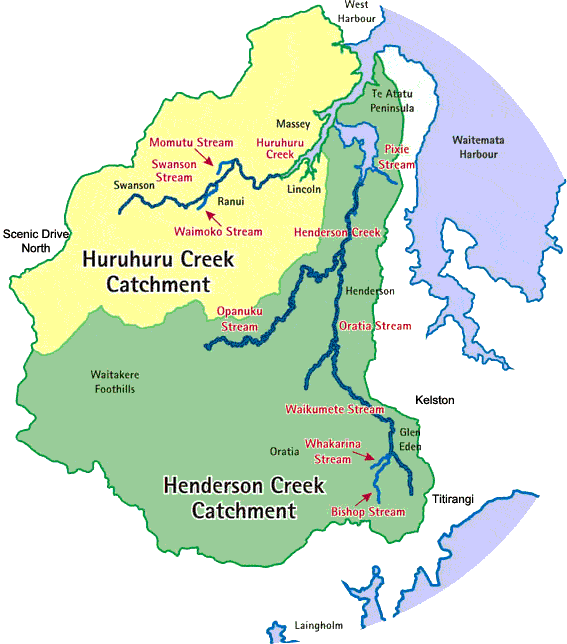Twin Streams floated their punt

Eco-City-Style: Waitakere City Council’s Project Twin Streams impressed the commissioners with its engagement of the community. map Waitakere City Council
Project Twin Streams features in the Royal Commission on Auckland Governance recommendations, and that is a promising sign for the Mahurangi.
The 788-page report, which is eminently readable, is peppered with examples that inspired the commissioners. The report includes Waitakere City Council’s description of Project Twin Streams:
The focus of the project is on restoring 56 kilometres of stream banks but the vision is wider. The council works with local communities that live alongside the stream, who carry out planting and maintenance—either at community planting days or via local organisations and businesses, which adopt specific areas. The project looks at how land within the catchment, [and] how households can become more sustainable, and how cycle and walkways along streams can reconnect communities while providing opportunities for recreation. The project’s main objective is to improve the streams and waterways within its area. The project is doing this in a number of ways: such as replanting 56 kilometres of stream banks and purchasing some properties that are situated within the stream’s natural route. The stream bank plantings will improve stormwater (the rainwater that runs off land into our drain system firstly and then into our rivers and streams) by creating buffer zones along the stream banks. These plantings will also help create the environment and habitat which encourages an increase in the number of native fish, birds, bats, lizards, geckos and insects in and around the streams.
The commission says its proposal to establish local councils should provide greater scope for local government to encourage, and cooperate with, community groups in the improvement of the city’s environment. Immediately ahead of the Twin Streams section, is the sole reference to the Mahurangi:
Matters providing cause for concern at the time that the report on the state of the region was written were the degradation of some of the lakes and the signs of ill health appearing in marine ecosystems in the Mahurangi Harbour.
Mahurangi Actionfounded in 1974 as Friends of the Mahurangi, and known by that name at time of publication’s submission included a plug for ‘some form of local community council’, suggesting that better engagement with the community would bring benefits to the efforts to reduce the elevated sediment accumulation rate. In the event, community boards were given the heave ho, with the exception of Great Barrier and Waiheke islands.
However, the commission notes that the new Auckland Council will have the power to establish any additional community boards it considers necessary. Rodney district, extending as it does from north of Te Aria Point virtually to Bethells Beach, is not a natural community of interest—the seven local council councillors provided for will not enjoy a great deal of shared focus. Accordingly, once it is bedded in, Auckland Council could conceivably consider reconstituting the proposed three wards as community boards—Tamahunga would make a fine name for the northern one. It is on issues like this that Rodney District Council should have concentrated its input to the royal commission process. Instead, the commission observed:
…that the submissions of the Rodney and Franklin district councils were directed principally at protecting the existence of those two councils, with limited regard to regional issues.
So much for Rodney’s billboard assault on the Auckland Regional Council, which chairman the Honourable Peter Salmon QC described as improper, if it was intended to influence the commission.
With or without community boards, the commission has firmly installed the place-making imperative. This nicely meshes with the nearly five years of work by Mahurangi Action—stimulated by the Mahurangi Action Plan—to grow the network of entities and individuals interested into an effective force for the restoration and enjoyment of the Mahurangi: The Mahurangi Initiative.
That should float many Mahurangi punts.
